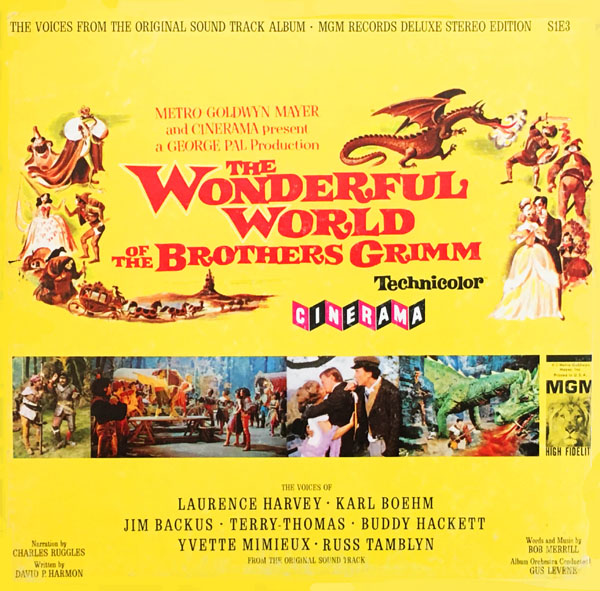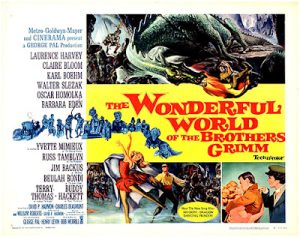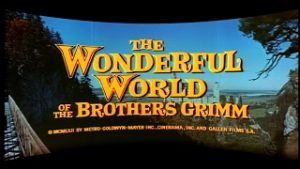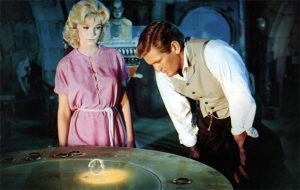The journeys of two great Pal-taculars (both with stop motion) to vinyl and disc were like adventures in themselves

MGM Presents A George Pal Production
THE WONDERFUL WORLD OF THE BROTHERS GRIMM
The Voices from the Original Sound Track
MGM Records S-1E3 (Stereo) 1E3 (Mono) (12” 33 1/3 RPM / Boxed with Hardcover Souvenir Book / 1962)
LP Reissue: MCA Records MCA-39091 (1986)
Narrator: Charles Ruggles. Producer/Editor: Jesse Kaye. Music Adaptation: Gus Levene. Story Adaptation: David P. Harmon. Running Time: 41 minutes.Performers: Laurence Harvey (Wilhelm Grimm, The Cobbler); Karl Boehm (Jacob Grimm); Russ Tamblyn (The Woodsman, Tom Thumb); Yvette Mimieux (The Dancing Princess); Beulah Bondi (Gypsy); Jim Backus (King); Clinton Sundberg (Prime Minister); Walter Brooke (Mayor); Sandra Gale Bettin (Ballerina); Robert Foulk (Hunter); Terry-Thomas (Sir Ludwig); Buddy Hackett (Hans); Otto Kruger (King); Martita Hunt (Story Teller); Arnold Stang (Rumpelstiltskin); Peter Whitney (Giant); True Ellison (Snow White); Pamela Beaird (Cinderella); Stanley Fafara (Hansel); Diana Driscoll (Gretel); Ruthie Robinson (Little Red Riding Hood; and the Voices of Stan Freberg and Dal McKennon (Elves).
The Wonderful World of the Brothers Grimm is the easily most lavish storybook fantasy feature film that millions have never seen. Or if they did, perhaps not in the full, expansive manner originally envisioned. One of George Pal’s favorite projects, Brothers Grimm was so big a project, his responsibilities dictated that he bring in Henry Levin to direct the connecting narrative thread sections.Songs/Instrumentals: “The Wonderful World of the Brothers Grimm”, “The Dancing Princess,” “Above the Stars”, “Ah-oom”, “Gypsy Fire”.
Pal directed three adaptations of Grimm fairy tales. Two of them, “The Dancing Princess” and “The Singing Bone,” were chosen because they were lesser-known and might seem more novel to audiences. The more familiar “Cobbler and the Elves” was perfect for filling the taller, triple-wide, wraparound Cinerama image with stop-motion Puppetoons. A fourth sequence, “The Dream,” combined as many fairytale characters as Pal could get into the sequence, including Russ Tamblyn (who plays two roles) returning in the role of “tom thumb” from Pal’s 1958 fantasy feature (the subject of this Animation Spin).
The rebirth of this magnificent 1962 Cinerama production on Blu-ray after a ten-year restoration odyssey is big news in an industry looking for new “content” when there are things the public rarely or never saw properly, to begin with. Brothers Grimm was considered a dead issue after years of indifferent neglect left the elements suffering water damage and other seemingly unsolvable problems, in addition to the time, money, and inside support needed.
For those of us who had only the music to enjoy and the Cinerama to imagine, there were several fine recordings but no soundtrack album of just the score and songs ever released on vinyl. When the film was first released, MGM Records decided to produce a deluxe boxed album with a hardcover book (adapted from the theater program) and a dialogue album, completely rescored with melodies from the film but no actual soundtrack music.
 The dialogue from the soundtrack is plentiful, with narration recorded by Charlie Ruggles just after he played Hayley Mills’ grandfather in The Parent Trap, and the same year he voiced Aesop for Jay Ward’s Aesop and Son cartoons. The soundtrack score of Leigh Harline (Pinocchio, Silly Symphonies) is replaced by a fully-orchestrated studio score arranged and conducted for the album by Gus Levene (arranger for The King and I, The Music Man, and other films).
The dialogue from the soundtrack is plentiful, with narration recorded by Charlie Ruggles just after he played Hayley Mills’ grandfather in The Parent Trap, and the same year he voiced Aesop for Jay Ward’s Aesop and Son cartoons. The soundtrack score of Leigh Harline (Pinocchio, Silly Symphonies) is replaced by a fully-orchestrated studio score arranged and conducted for the album by Gus Levene (arranger for The King and I, The Music Man, and other films).
Brothers Grimm is not a ”book musical” but instead a fantasy with songs by Bob Merrill (Funny Girl, Mr. Magoo’s Christmas Carol). The album presents them briefly in deference to the story. The catchy main title song was the most frequently covered piece from the Merrill compositions, recorded by David Rose, Lawrence Welk, Don Costa, Henry Mancini, and Les Baxter.
The album contains generous helpings of the two major stop-motion sequences, with Stan Freberg and Dal McKennon, two favorite Pal voices, as the Elves. The song, “Ah-Oom,” is re-created for the album with what sounds like session singers, including the legendary Bill Lee.
“The Wonderful World of the Brothers Grimm”
The Voices from the Original Soundtrack Album
When MCA reissued this album with a different cover in the eighties (without the box and the book), the words “Music from the Motion Picture” were emblazoned across the top. When a friend told me he saw a “Brothers Grimm soundtrack” in the record store, I searched for what seemed like hours. I knew about the incorrect reissue but hoped against hope that MCA might have also produced a new album, which was not yet to be. No one at MCA Records seems to have listened to the record or knew the difference if they had. In their defense, the film was difficult to access.

THE WONDERFUL WORLD OF THE BROTHERS GRIMM
Original Motion Picture Soundtrack
Film Score Monthly FSM Silver Age Classics Vol. 13 No. 4 (Two Compact Discs / 2010 / Stereo) Also includes soundtrack music from The Honeymoon Machine (1961)
The true Cinerama version of Brothers Grimm was produced in seven-track stereo, which may have a lot to do with the complexity and cost of making a soundtrack album in 1962. “Wonderful” as the cover versions of the music story album above were, an actual soundtrack was the stuff dreams were made of. This 2010 Film Score Monthly two-disc set was a massive accomplishment. The entire Leigh Harline background score, all the Bob Merrill songs in various forms and reprises, medleys, and transitions are included in full stereo.
Bonus tracks include alternate versions, even what Buddy Hackett sounded like before his voice was processed by Sonovox for “The Singing Bone.” In addition, the complete MGM David Rose LP is included featuring five songs and melodies as well as other movie songs. An additional soundtrack, Harline’s peppy score for The Honeymoon Machine, a silly romantic comedy with an unlikely Steve McQueen, caps off the package.

Even though the CD is out of print, Film Score Monthly’s website has retained the exhaustively thorough liner notes containing much more information on the film and its music than could be described in this post. Go to this page
for the track listing and basic information but click where the words “The Wonderful World of the Brothers Grimm” is highlighted at the top right above the track list. The track list itself offers a sample of every track on the 72-minute album.
 Cinerama began in 1952, six years before stereophonic records were even available to the public, before other wide-screen movies, and even the opening of Disneyland. It’s well known that the threat of television had the movie industry in a panic. The movie studio powers-that-be sought magical answers as well as advice, like letting go of people they later realized they needed (like animation departments).
Cinerama began in 1952, six years before stereophonic records were even available to the public, before other wide-screen movies, and even the opening of Disneyland. It’s well known that the threat of television had the movie industry in a panic. The movie studio powers-that-be sought magical answers as well as advice, like letting go of people they later realized they needed (like animation departments).
The Cinerama process was very expensive and limited in its capabilities, but it was an attention-getting, potentially career-making media sensation. Cinerama films were an event again and people traveled for miles to see them. In the early sixties, two Cinerama full-length features with celebrity casts and stories were set in production simultaneously. A total of five directors worked on the two features, including Pal and Levin.
John Ford, George Marshall and Henry Hathaway each directed a section of How the West Was Won, a feature perfectly timed for its era and loaded with the biggest stars of the day. In the numbers, it eclipsed The Wonderful World Brothers Grimm, a classic-style family fantasy without the benefit of the Walt Disney name, substantial stars but not major marquee names and an overall “little kids should like this kind of stuff” consensus. Grimm was nonetheless one of the year’s big moneymakers, but West hit a level in its day that Grimm could not reach. No further features were ever filmed in the original Cinerama format. The process was modified into a one-camera widescreen version. While still very impressive in such classics as It’s a Mad Mad Mad Mad Mad World, and 2001: A Space Odyssey, this was not the “true” Cinerama, just as latter-day IMAX in smaller neighborhood theaters wasn’t quite the same as the original IMAX. Cinerama eventually became a trademark and a releasing company.
The Brothers Grimm fell into a similar fate as Wilhelm’s fairy tales almost did, rarely seen except in a highly reduced quality. The major networks never broadcast the film, while How the West Was Won was a sixties and seventies TV staple. Grimm was relegated to one-dollar children’s matinees under heavily traveled print conditions. The best version possible was released on VHS in 2006 and shown on TCM. This was a reduced circumstance under which most people formed their perceptions about its overall quality. The Cinerama Dome in Hollywood presented the best version available in 2015 but even then, it was not restored to the degree that it is now and therefore judgments have been distorted by any number of circumstances.
There were always those who believed in The Wonderful World of the Brothers Grimm and its lasting value in classic storybook filmmaking in the grandest possible scope. The new fully restored Blu-ray edition comes with a widescreen version and a “smilebox” disc that simulates the wraparound effect of Cinerama. It seems weird at first, but allow a few minutes to get used to it because you will see that the sets, art direction, and most photography were usually designed for the curved screen and wide-angle lens. Smilebox or widescreen, the film looks better than it was believed it could ever look.

Fictionalized as The Wonderful World of the Brothers Grimm is (what biopic is not?), the central struggle of Wilhelm Grimm to research, preserve and establish the worth of supposed “quickly read, easily forgotten” fairy tales strikes at the heart of those of us dedicated to similar bittersweet lives hopelessly and joyously devoted to such “other man’s trash” in the face of bewilderment and snark. I was a little verklempt by the end and I am not sorry.
Main Title from The Wonderful World of the Brothers Grimm
Written by Bob Merrill, conducted by Leigh Harline, the David Rose Orchestra version of this tune was released by MGM as a single and it got a lot of airplay on AM and easy listening stations. The satellite system Music Choice still plays various versions of this theme in its rotation.

Recently released restored Time Machine original score CD
Like Brothers Grimm, George Pal’s The Time Machine (1960) is highlighted by stop-motion as well as special effects that still astonish in their inventive artistry. Composer Russell Garcia (Limelight, Playhouse 90, The Wild Wild West) was Pal’s inspired choice to score this classic with eclectic themes and orchestration, just as inventive and endlessly replayable.
Also like Brothers Grimm, there was no Time Machine soundtrack or score LP album at the time of its release, except for a Verve Records’ 45 single with the Main Theme on one side and the “London 1900 Theme” on the other. Decades passed until listeners were able to enjoy Russell Garcia’s music, and the first time it ever appeared on recordings it was as a stunning digital re-creation by Garcia himself, which has now been restored to an even more crystalline brilliance.
“Russ Garcia was the kind of person who didn’t brag about himself,” said Arnold Leibovit, producer of The Fantasy Worlds of George Pal (the feature film and the CD set). Leibovit has also produced two volumes of The Puppetoon Movie (more info here) and many other projects devoted to the creativity of Pal and the great people whom he offered opportunities to shine, including Russell Garcia.
Garcia’s work in film and television is well known even if his name may not be familiar to everyone. In this interview with Randall L. Larson, Garcia recalled his work on the 1952 classic Limelight: “Charlie Chaplin wrote the themes, the melodies. He was a real talent. The pianist that went to rehearse with Charlie — Charlie would sing or play one finger on the piano and Ray Rasch was the pianist — and he said, ‘Ray, why don’t you score this film? I’ve written all the melodies, why don’t score it?’ Ray said ‘Okay,’ but he didn’t know how to orchestrate, so he got me to work with him and I orchestrated the whole film. Of course, we had to do a lot of composing with Charlie’s themes, but they were all Chaplin’s themes.”
George Pal was impressed with Garcia’s work on a 1958 Liberty Records LP called Fantastica: Music from Outer Space. It is considered a forerunner of the “space music” concept album trend, during the home stereo system craze of the late fifties and early sixties when the “stereo” was proclaimed on LP covers and liner notes were accompanied by sonic charts.
“You can hear a lot of what influenced George in Fantastica,” Leibovit said. “George really understood music. So, Russ thought, ‘Oh boy, I’m going to get to write something really spacey and far out. But George didn’t like it too much, so Russ came up with something a little more ‘folksy,’ so to speak. George liked that, and what ended up happening is that Russ incorporated both ideas — the melodic, more emotionally stirring, and sweeter elements — and that he still brought in other ideas and it ended up becoming a little of both.” Leibovit’s extensive liner notes detail the remarkable range of innovative electronic and tactile sounds Garcia brought into the recording.
In 1987, Garcia and Leibovit decided to digitally re-record The Time Machine score from scratch, with only Garcia’s conductor’s score as a guide. “Russ had to write out the orchestrations for every instrument so that it would match the original way he had written it. That’s a big undertaking,” said Leibovit.

George Pal, Walt Disney and Walter Lantz
The 1987 CNP Crescendo Time Machine release was mixed and edited to match the film soundtrack, which was still not available on CD. According to Leibovit, there were changes in speed and other modifications. A suite was also added from Atlantis: The Lost Continent.
In 2005, Film Score Monthly finally released a limited edition Time Machine album of the MGM soundtrack (FSM Vol. 8 No. 13.). The music is in stereo with Garcia’s unique sound effects in mono. Since it was limited, it is now out of print.
Believing the score should be available for all to enjoy, Leibovit went back to the studio with the original digital elements of the 1987 version. The result is a restored limited edition available on the Puppetoon website and other retailers.
The restored and enhanced version contains several additional minutes of music. Some are noticeable right away. The Main Title begins with more notes than in the Crescendo edit. In comparing the two versions, there is a more specific prominence and clarity among the instruments and sections.
“I wanted people to be able to have the score to The Time Machine sounding exactly as Russ created it for George. When you listen to it, the music really transports you to another place and time – into the movie itself, or the times when you watched it.”
Great music is a great time machine.

[Portions of this post contain a sliver or two of earlier material.]





 GREG EHRBAR is a freelance writer/producer for television, advertising, books, theme parks and stage. Greg has worked on content for such studios as Disney, Warner and Universal, with some of Hollywood’s biggest stars. His numerous books include Mouse Tracks: The Story of Walt Disney Records (with Tim Hollis). Visit
GREG EHRBAR is a freelance writer/producer for television, advertising, books, theme parks and stage. Greg has worked on content for such studios as Disney, Warner and Universal, with some of Hollywood’s biggest stars. His numerous books include Mouse Tracks: The Story of Walt Disney Records (with Tim Hollis). Visit 





















































Thanks for this great post! I recognize that some of this material has been shared before, but not as comprehensively as it is here. It’s a real treat to hear the Charles Ruggles album again, which I had when I was a child.
I was in existence when the original Brothers Grimm movie was released, but I was far too young to have seen or appreciated it. So I missed it–but not completely. When I was about four or five, my parents gave me for my birthday the box set record album of the “Brothers Grimm” movie, which delighted me of course but at the time had zero name recognition value for me, as I had never seen or heard of the movie. Still, I treasured this beautiful gift. I always kept the book and record set in the same condition it was given to me, and I still have it somewhere (I believe it is in a storage unit in Seattle right now).
I finally got to see “The Wonderful World of the Brothers Grimm” when it aired on the Disney Channel in the mid-1980s. Since then, it has also aired on TCM, where I saw it around Christmas time last year. I’m hoping the new Blu-ray includes a DVD version.
I wish I had been able to see the original Cinerama presentation of this film. Maybe someday a restored version will be available in that format. One can only hope. But, hey, wishing and hoping are what fairy tales are all about, right?
Not to ignore the news about the new Time Machine release. Another George Pal classic. I will have to check that one out, too.
It’s always a treat to hear from you, Greg! I am so glad you are still posting!
Thanks for noticing I’ve been away. Right now I’m posting about once a month while I work on my book (more to come on that), My guess is that the widescreen restoration of Brothers Grimm will eventually make the new version more accessible than the VHS and occasional cable viewings, so it can gain the audience it should. Maybe TCM will run the new version this Christmas and HBOMax will start streaming it, since the film is perfect for the holidays.
I beleive “The Dancing Princess” story was someting told as “12 Dancing Princesesses” but I understand why this was reduced to one for budgetary reasons (the Cinerama process was expensive enough!).
Reguarding “The Time Machine”, I always wanted to know: Was the off-screen drunk that was trying to sing “Auld Lang Syne” during the New Years scene Stan Freburg? It sounded like him.
Although Kurt Graunke studied music in Berlin, he did not establish his symphony orchestra there but in Munich. Speaking of conductors, actor Karl Boehm, who played Jacob Grimm in the film, was the son and namesake of renowned Austrian conductor Karl Boehm. He was highly regarded in his day, but his interpretations are too heavy and sluggish for my taste. (Boehm’s recording of Beethoven’s Ninth Symphony, which by rights should take an hour or just a bit more, lasts fully 78 minutes.)
Stanley Fafara, who played Hansel, also played Beaver’s friend Whitey Whitney in “Leave It to Beaver”. He struggled with drug and alcohol addiction for many years and was therefore the only original cast member to be replaced in the TV reunion movie of the ’80s, in which Whitey was played by Ed Begley, Jr.
I can’t help noticing that Yvette Mimieux was in both films covered in this post. George Pal must have liked her work. Well, who wouldn’t? She was by far the best thing about Disney’s “Monkeys, Go Home!” — and that includes Maurice Chevalier. She passed away earlier this year at the age of 80.
Yvette Mimieux is heard in a 1962 promotional radio interview in the Blu-ray bonus features. The Time Machine was her feature debut, though sources seem to differ as to who “discovered” her for either TV or film.
Excellent post. I’m hoping that the new restoration of BROTHERS GRIMM will attract new fans to this fascinating, one-of-a-kind movie.
Stephen Bosustow and Max Fleischer were cut out of that photo of Walt Disney with George Pal.
Cool! Thanks for letting us know that there were originally four historic people in the photo. Do you have the complete image? We would sure like to post the complete image so everyone can enjoy it.
The original, uncropped photo shows (l. to r.) George Pal, Walt Disney, and Walter Lantz. It was taken at an event celebrating Lantz’s 25 years with Universal Studios in 1953. The shadow behind Walt Disney’s left shoulder is part of a silhouette of Woody Woodpecker that was painted on the wall. Another photo from the same event can be seen in Jerry Beck’s Animation History column for 21 January 2019.
The full photo has now been added to the post above. Stephen Bosustow and Max Fleischer were never part of this image.
So enjoyed reading this, Greg. Growing up in a small town, I remember going to see “Grimm” but certainly not in CINERAMA. I also still have the Gold Key Comic as a reference.
“The Time Machine” has ALWAYS been one of my top favorite films-I disagree with Leonard Maltin’s “reduced to comic-book level” capsule review. But as some have pointed out “Leonard isn’t always right!”
I had the good sense to send my Dell 4-color comic to Rod Taylor, requesting an autograph on it, with a check I think for $25. He sent it back- personally autographed to me-with the check torn in half! About three months later, he passed away..
Thanks for this article.